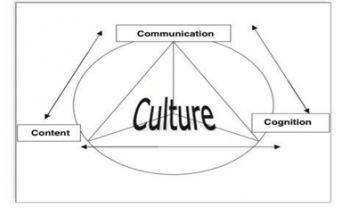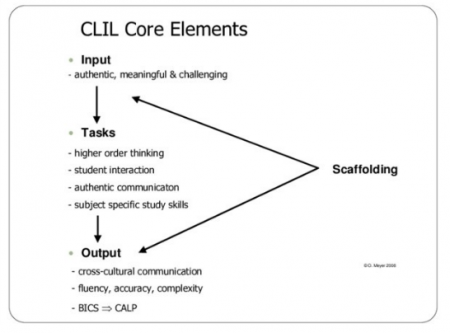Content and Language Integrated Learning (CLIL) is a dual-focused educational approach in which an additional language is used for the learning and teaching of both content and language. It’s a pedagogical approach which has an integrated aim: learning of the subject content and learning of the language used as the medium of instruction for the content.
The aim of CLIL lessons is to integrate the language and content in order to teach both the subject matter and language is learned.
According to Coyle’s 4Cs curriculum (1999), a successful CLIL class should include the following four elements:
Content –knowledge, skills and understanding related to the subject curriculum;
Communication – using a language to learn;
Cognition – developing thinking skills which link concept formation, understanding and language;
Culture – thinking of alternative perspectives and shared understanding in order to deepen cultural awareness.
There are several key CLIL strategies according to Meyer (2010):
- Rich input. The input should be meaningful and challenging. A teacher needs to prepare the content that improves both subject knowledge and students’ language skills. The content should be related to students’ interests and based on their needs.
- Scaffolding learning. Students should be taught how to learn efficiently. Working with maps, diagrams, mind maps, tables or pictures must be practiced continually individually, in pairs and in groups.
- Effective interaction. Teachers should develop students’ linguistic abilities, including listening, reading, writing and speaking skills.
- Adding the (inter-)cultural dimension. In CLIL lessons, students look at various topics from different cultural angles. They realize that people have different cultures, values and beliefs. They receive valuable experiences. Students know that cultures differ in many aspects, including views and perceptions.
- Fostering higher order thinking. Teachers need to prepare tasks, activities and games to create an engaging and challenging environment. But at the same time students should not be overwhelmed.
- Sustainable learning. Teachers have to organize and encourage systematic active learning by engaging students in various interesting activities. Students need to be taught how to analyze and solve problems.
BICS stands for Basic Interpersonal Communication Skills or Basic Language Skills. Also, it refers to linguistic skills needed in everyday, social face-to-face interactions. Cognitive Academic Language Proficiency (CALP) focuses on proficiency in academic language or language used in the classroom in the various content areas.
The key elements of CALP are the following:
- context reduced (topics are abstract, context reduced, and specialized);
- cognitively demanding (specialized vocabulary and more complex language structure);
- focuses on proficiency in academic language or language used in the classroom in the various content areas;
- improves comparing, classifying, synthesizing, evaluating, and inferring.
In general, by implementing CLIL strategies teachers can develop both students’ language skills and content knowledge. Furthermore, students’ communication and collaboration skills, higher order thinking, critical and creative thinking, cultural awareness and fluency could be improved through effective teaching.
References
- Dale, L., Es, U. and Tanner, R. (2011). CLIL skills, European Platform - Internationalising education.
- What is Content and Language Integrated Learning? https://www.english.com/blog/content-and-language-integrated-learning/
- Coyle, D. (1999). CLIL - A Pedagogical Approach from the European Perspective. Springer.
- Why a student who speaks English fluently still scores low grades https://www.clilmedia.com/
- What is CLIL? http://clilvet.erasmusproject.pl/
- What is CLIL? https://www.onestopenglish.com/clil/what-is-clil/501038.article
- CLIL Activities, Cambridge University Press, ISBN: 9780521149846
- Meyer, O. (2010). Towards quality-CLIL: successful planning and teaching strategies, PULS, 33, 11-29
- What are BICS and CALP? https://www.colorincolorado.org/

